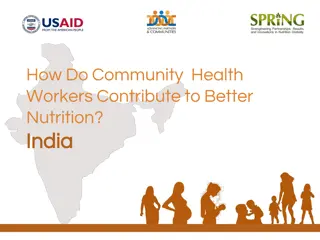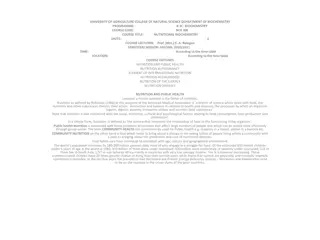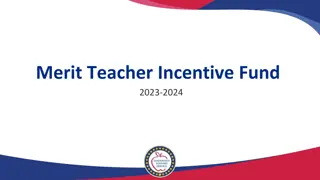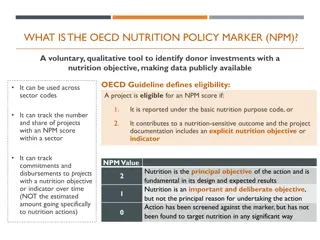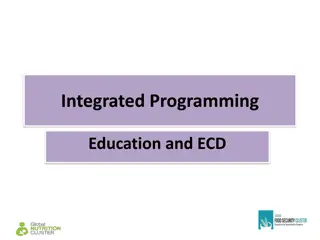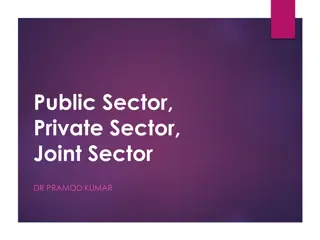Performance Bonuses in Public Sector for Child Nutrition Improvement in India
Examining the effectiveness of performance bonuses in the public sector for reducing child malnutrition in India, focusing on incentivizing salaried Anganwadi workers in the ICDS program to improve nutrition outcomes. Challenges in implementing performance pay, monitoring child nutrition inputs and outcomes, and previous research findings on incentive design are discussed.
Download Presentation

Please find below an Image/Link to download the presentation.
The content on the website is provided AS IS for your information and personal use only. It may not be sold, licensed, or shared on other websites without obtaining consent from the author.If you encounter any issues during the download, it is possible that the publisher has removed the file from their server.
You are allowed to download the files provided on this website for personal or commercial use, subject to the condition that they are used lawfully. All files are the property of their respective owners.
The content on the website is provided AS IS for your information and personal use only. It may not be sold, licensed, or shared on other websites without obtaining consent from the author.
E N D
Presentation Transcript
Performance bonuses in the public sector: Winner-take-all versus proportional rewards to reduce child malnutrition in India Prakarsh Singh Department of Economics, Amherst College Will Masters Friedman School of Nutrition & Department of Economics, Tufts University University of Pennsylvania Center for Advanced Studies on India (CASI) Conference on Child Development in India, 15-16 September 2017
A test of performance bonuses for ICDS workers in Chandigarh
Performance bonuses for child nutrition motivation | trial design | outcomes | mechanisms Can performance bonuses help salaried workers improve public services? Performance pay is difficult to use and evaluate Measurement of performance is costly, affected by noise, time lags and confounders Rewards may crowd out other motivations, and reduce effort on other tasks Rewards may drive selection into participation and allocation of effort Efforts to improve child nutrition are difficult to monitor and improve Inputs (dietary intake and disease exposure) are usually not observed Outcomes (body size, disease state) are difficult to measure and compare Links between inputs and outcomes are unknown India s ICDS program offers a large-scale opportunity to intervene Over 1 million centers each serving over 30 preschool children, with salaried Anganwadi worker providing mid-day meal, advice to mothers, some teaching Government aims to improve performance for both nutrition and education Objectives include reduced weight-for-age malnutrition, which is still widespread Low weight-for-age, defined as WAZ < -3 or -2 standard deviations below median of a healthy population, can be due to either inadequate diet or disease burden
Performance bonuses for child nutrition motivation | trial design | outcome Our contribution: design of incentives Previous work in other settings test many kinds of performance pay In health, reviewed for developing countries by Miller & Babiarz 2014 In education, e.g. Behrman et al. 2015 for secondary schools in Mexico Previous work with ICDS workers to reduce child malnutrition has found: Information plays a central role (Singh 2015 in JEBO, from earlier Chandigarh trials) Goal cards for workers, recipe books for mothers Principal mechanism is targeting communication with mothers about at-risk children Magnitude of incentive matters (Singh & Mitra 2017 in EER, from Kolkata trials) Significant impact for 200 but not 100 Rs per child Payments affect intrinsic motivation (Singh & Masters 2017 in JHE, from Chandigarh) Fixed bonuses of 200 Rs elicit almost as much gain as 200 Rs per child who improves Now, focus on contests with known payout of equal expected value Contests are widely used in many settings (McKinsey & Co 2009) Fixed timeline and known payout facilitates budgeting Rank order tournaments create high-powered incentives (Lazear and Rosen 1981) but also discouragement (Brown 2011, Cason, Masters & Sheremeta 2010, 2017) Divisible prizes can be paid in proportion to success, incentivizing all improvements
Performance bonuses for child nutrition motivation | trial design | outcomes Summary of results Trial compares two incentive schemes using identical information, offering performance bonuses of identical expected value (<5% of salary) For 85 workers serving about 2,000 children in government-run ICDS day-care centers in urban slums of Chandigarh, India Mechanism checks address heterogeneity, workers job satisfaction and efforts reported by mothers, with check for parallel trends before intervention We randomize individuals workers within neighborhood clusters Compare standard winner-take-all (WTA) prize paid to highest performer to a proportional reward payment (PRP) divided among all successful caregivers Criterion is number of children whose weight-for-age status improves Contest is within clusters, offering up to 600 Rs per worker in that cluster Gains from proportional rewards exceed gains from winner-take-all prize especially after contest ends, with after 6 mo. (5.9 pct pts) vs 3-mo. contest (4.3 pct pts) mechanism is greater impacts from poorer performers, who also report higher job satisfaction after the contest ends
Performance bonuses for child nutrition motivation | trial design | outcomes Context for this trial In urban slums of Chandigarh -- Planned city in far north India -- Capital of both Punjab and Haryana -- Population size < 2 million Previous paper: fixed bonus vs piece rate Design and implementation done with ICDS management -- Geographically separated blocks -- Previous paper compares block 1 as controls for trends and seasonality to block 2 for fixed bonus vs. piece rate -- This study s data collected in 4 rounds at 3 month intervals, Oct 2014 - July 2015, with surveys of workers, children and their mothers This study: Incentive design
Performance bonuses for child nutrition motivation | trial design | outcomes Design of this trial Results of individual randomization within neighborhood clusters Number of Anganwadi workers (centers) Total Adarsh Badheri Buterla Dhanas Ramdarbar Sector 52 WTA PRP Randomization occurred within clusters 3 2 2 * 2 2 3 4 4 19 14 3 43 19 15 4 42 38 29 7 85 Number of children (at first endline) Total 121 132 WTA 121 PRP Adarsh Badheri Buterla Dhanas Ramdarbar Sector 52 * 62 56 70 37 468 403 137 93 973 777 244 505 374 107 2,340 1,225 1,115 * Adarsh had only 3 centers, so could be allocated only one type of contest, which was randomly picked to be WTA
Performance bonuses for child nutrition motivation | trial design | outcomes Timeline of the trial Baseline I (October 2014) Baseline II (January 2015) Assigned to treatment in early February 2015 Endline I (April 2015) Payouts given in early May 2015, no further incentive offered Endline II (July 2015)
Performance bonuses for child nutrition motivation | trial design | outcomes Treatments Scalable design: Bonus pool in each cluster total Rs. 600 per worker Equal expected value and timing of payment in each treatment arm In WTA treatment, the highest performer wins the entire bonus pool In PRP treatment, each successful performer wins their share of the bonus pool Simple implementation: Goal cards with gains needed for each child Status improvements can be from severe (WAZ<-3) to moderate (WAZ<-2) or to none Status improvements exclude any cases of overweight relative to height (WHZ>+1) Bonuses are net of any declines in status into moderate or severe malnutrition Bonuses have lower bound of zero
Performance bonuses for child nutrition motivation | trial design | outcomes Baseline descriptive statistics WTA PRP WTA PRP Demographic characteristics Child age Child is male Mother age Number of children Household income Mother illiterate Worker age Worker college Child diet (foods consumed at least 2x/week) Milk Dal Green Veg Fruit Sweets Egg Dalia Chicken Roti Chips 4.6 0.50 27.2 2.35 8,639 0.38 37.70 0.43 4.6 0.51 27.2 2.29 8,380 0.36 38.95 0.45 1.00 0.96 0.60 0.48 0.13 0.25 0.89 0.11 0.92 0.43 0.99 0.95 0.56 0.49 0.23 0.27 0.88 0.13 0.94 0.38 Child weight outcomes Weight for Age (WAZ) Malnourished (WAZ<-2) Weight (kg) -1.54 0.27 13.73 -1.48 0.28 13.81 Worker effort Home visits Talks about child Group AW meetings Other mother mtgs 7.61 10.62 4.29 8.32 6.41 11.26 3.73 9.35 Worker nutrition knowledge Quiz 1 (18 questions) Quiz 2 (25 questions) Quiz 3 (7 questions) 10.72 15.21 4.48 11.10 15.76 4.66
Performance bonuses for child nutrition motivation | trial design | outcomes Expected and actual payouts Ex-ante design WTA 43 6 600 PRP 42 5 600 Total number of workers Total number of slum clusters Expected payout per worker Ex-post outcomes Average payout per worker Average payout per payee Number of workers receiving payouts Number of clusters without payouts 279* 4000 3* 3* 600 1575 16 0 * In the WTA arm, 3 of 6 clusters had no net improvement, hence no payout
Performance bonuses for child nutrition motivation | trial design | outcomes Weight-for-age outcomes
Performance bonuses for child nutrition motivation | trial design | outcomes Results: ATE for child nutrition outcomes Impacts of PRP (vs. WTA) Weight (1) Wfa z (2) Wfa mal (3) Weight (4) Wfa z (5) Wfa mal (6) Weight (7) Wfa z (8) Wfa mal (9) Within the contest period (after 3 months) Proportional 0.0764 0.0705* -0.0432* 0.138 0.0638 -0.0381 0.138 0.0642 -0.0369 Child and mother-level controls Worker Controls N X X X X X X X X X 2348 2342 2342 1665 1665 1665 1665 1665 1665 Over the longer term (after 6 months) Proportional 0.202 0.0951* -0.0589** 0.209** 0.0875* -0.0517* 0.200* 0.0824* -0.0496* Child and mother-level controls Worker Controls N X X X X X X X X X 2325 2272 2272 1935 1934 1934 1935 1934 1934 Dependent variables are Weight (kg), Wfa z (WAZ), Wfa mal (status indicator) Significance levels shown are * 10%, ** 5%, *** 1%.
Performance bonuses for child nutrition motivation | trial design | outcomes Results: Heterogeneity among workers Impacts of PRP (vs. WTA) Wfa z (1) Weight (2) Wfa z (3) Weight (4) Wfa z (5) Weight (6) Within the contest period (after 3 months) Proportional (PRP) Difference to Mean Payout Difference to Mean Payout*PRP Child and mother-level controls Worker Controls N 0.076 0.0256 -0.0376 0.0638 0.0181 -0.0158 X 0.138 0.0342 -0.0317 X 0.0642 0.018 -0.0163 X X 1665 0.138 0.0341 -0.0316 X X 1665 0.0703* 0.0111 -0.0101 2342 2348 1665 1665 Largest gains were among workers with lower payouts Over the longer term (after 6 months) Proportional (PRP) Difference to Mean Payout Difference to Mean Payout*PRP -0.0508*** Child and mother-level controls Worker Controls N 0.0947* 0.0351** 0.203* 0.0403 -0.0935** 0.0880* 0.0307** -0.0447*** X 0.210** 0.0667** -0.0920*** X 0.0836* 0.0278** -0.0377*** X X 1934 0.202** 0.0610** -0.0783*** X X 1935 2272 2325 1934 1935 Difference to mean payout coefficients are in thousands of rupees Dependent variables are Weight (kg), Wfa z (WAZ), Wfa mal (status indicator) Significance levels shown are * 10%, ** 5%, *** 1%.
Performance bonuses for child nutrition motivation | trial design | outcomes Mechanism: Satisfaction and discouragement Workers who won larger payouts gained confidence in their ability from PRP but PRP led to higher life satisfaction among those with lower payouts Impacts of PRP (vs. WTA) on workers self-reported satisfaction with their own ability, their work at ICDS, and their life in general Ability (1) -0.0256 -0.0178 -0.170** 0.282*** -0.0188 -0.183** 0.275*** -0.0240 -0.186** 0.253*** 0.288*** 0.0910 -0.432*** 0.295*** 0.108 Child and mother-level controls Worker Controls N 4192 4132 4242 Work (2) -0.447 Life (3) 0.358 Ability (4) -0.0435 -0.464* Work (5) Life (6) 0.197 Ability (7) -0.0613 -0.461* Work (8) Life (9) 0.142 Proportional (PRP) Diff. to Mean Payout Diff. to Mean Payout*PRP -0.416*** 0.314*** X 0.111 X X 1912 -0.354*** X X 1957 X X X X 1934 1912 1957 1934 Difference to mean payout coefficients are in thousands of rupees Dependent variables are Weight (kg), Wfa z (WAZ), Wfa mal (status indicator) Significance levels shown are * 10%, ** 5%, *** 1%.
Performance bonuses for child nutrition motivation | trial design | outcomes Conclusions Contests with known payouts and fixed timelines can improve outcomes even (or especially) after the contest ends Bonus of ~5% of salary lowered malnutrition rates by 6% after 6 months, 4% after 3 mo. Larger gains at 6 months than 3 months could be due to Slow impact of workers actions on child weight gain Slow impact of contest design on workers action Proportional rewards encourage all workers, not just top performers Larger gains among those with below-average initial outcomes Higher life satisfaction among those below-average workers Results consistent with previous work Avoids discouragement effect found in laboratory trials (Cason, Masters & Sheremeta 2010, 2017) and athletic events (Brown 2011) Gains from gift-exchange mechanism (Akerlof 1982) as more workers win something Addresses heterogeneity among workers, in addition to revealing which actions benefit which children (Singh and Masters 2017)
Performance bonuses for child nutrition motivation | trial design | outcomes Conclusions Some states may want new incentives Written by Hamza Khan | Jaipur | March 9, 2017 Addressing the media after the budget, she said that her government has focused on delivering essentials . also announced 17.06 per cent higher allocation for Women and Child Department. This includes Rs 250-500 per month incentive for Anganwadi workers based on performance



